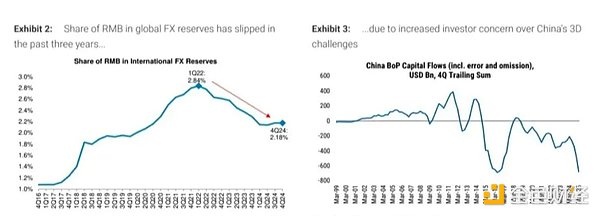Note: Recently, everyone has been talking about stablecoins. Jinse Finance has previously summarized the discussions on stablecoins from senior government officials, entrepreneurs, economists, national think tanks, securities firms and other Chinese people from all walks of life. Please refer to "How will China respond to the shock wave of US dollar stablecoins".
On May 19, Xing Ziqiang, chief economist of Morgan Stanley China, also led the publication of a research report "Stablecoins and RMB internationalization?" Let's take a look at how foreign securities firms view stablecoins and their impact on RMB internationalization.

Full text as follows:
We believe that China's recent new interest in stablecoins is due to concerns that US stablecoin legislation may expand the dominance of the US dollar. The People's Bank of China is using Hong Kong as a testing ground for future payment alternatives. But tokenization alone cannot make the RMB international. The real work lies in domestic reform.
Why is Beijing focusing on stablecoins now?
The US Senate passed the GENIUS Act, which requires that US dollar stablecoins must be fully backed, marking a turning point. If the bill passes the House, it would essentially transform dollar-pegged stablecoins (which currently account for 99% of the stablecoin market) into synthetic dollars and embed them deeply into the global payments system, thereby increasing demand for US Treasuries.
In our view, this is not a challenge to the dollar’s dominance—it is a further strengthening of it. Stablecoins are not new currencies, but new distribution channels for existing currencies. They extend the dollar’s influence to cryptocurrencies, Web3, and emerging markets through low-cost, nearly instant settlement.
For China, ignoring this trend risks falling behind in the race for digital infrastructure, especially as stablecoins increasingly serve as a mechanism to bypass traditional banking networks.
China’s Central Bank’s Pivot—From Ban to Blueprint
Since September 2021, cryptocurrency trading has been illegal in mainland China due to regulators’ concerns about financial stability risks. But central bank governor Pan Gongsheng signaled a policy shift in his speech at the Lujiazui Forum this week: he called for a multipolar global monetary system and pledged to ensure the security of international transactions. As efficiency improves and technology matures, digital RMB and stablecoins are proposed as viable alternatives for cross-border settlement. Governor Pan specifically pointed out that digital technology has exposed the weaknesses of traditional cross-border payment systems, which are inefficient and vulnerable to geopolitical risks.
RMB Stablecoins - Prospects and Constraints
Currently, cross-border digital RMB settlement mainly relies on the M-Bridge project, a multi-central bank digital currency platform developed by the Bank for International Settlements (BIS). However, the project is still small in scale, with only five central banks participating, and the BIS's withdrawal in October 2024 may slow down future expansion. In theory, RMB stablecoins have the characteristics of decentralization, accessibility and high efficiency, making them a good supplement to cross-border transactions. However, domestic bans, capital controls remain in place, and the lack of global recognition under the dominance of US dollar stablecoins have all restricted the development of RMB stablecoins.
Hong Kong - Strategic "Sandbox"
Hong Kong is the first jurisdiction in the world to pass stablecoin legislation, which came into effect on August 1. The Stablecoin Act requires stablecoins to be backed by 100% high-quality reserves and pegged to the corresponding currency (whether it is the US dollar, Hong Kong dollar or offshore RMB) - this actually paves the first legal path for offshore RMB stablecoins. According to the legislation, Hong Kong will first promote stablecoins pegged to the US dollar and Hong Kong dollar to build technical and market trust, and then promote stablecoins pegged to offshore RMB. Relying on Hong Kong's deep offshore RMB liquidity pool (about 1 trillion RMB), offshore RMB stablecoins will provide verification for the actual application scenarios of cross-border settlement without violating mainland capital controls or affecting onshore financial stability. The increase in offshore RMB use will also drive demand for RMB assets (such as offshore RMB treasury bonds and central bank bills).
Stablecoins are tools, not strategies
It should be clear that the rise of stablecoins does not mean the establishment of a new "super-sovereign" international monetary system. In fact, stablecoins are just an extension of existing legal tender under regulation to facilitate cross-border transactions. In this sense, we believe that the development of RMB stablecoins should be seen as a potential component of China's cross-border RMB settlement infrastructure, which also includes RMB swap agreements, the Cross-Border Payment System (CIPS), and the global RMB clearing service network.
Infrastructure construction is not everything, RMB internationalization is still a long-term battle
Although Beijing is accelerating the construction of cross-border settlement infrastructure, RMB internationalization has retreated in the past three years, with the RMB's share of global reserve currencies falling to 2.2% by the end of 2024 from 2.8% at the beginning of 2022. This is mainly because the market is worried about China's "three D challenges" (debt, deflation and demography) and weakened capital flows, offsetting the growth of RMB use in trade.
This means that the key to promoting the global use of RMB lies in global confidence in China's economic growth potential. To this end, we believe decisive structural measures are needed to achieve economic rebalancing and break the deflationary cycle through consumption-driven, including social welfare reforms, debt restructuring, tax reforms, and a growth-promoting regulatory environment. All of these are difficult reforms that can only be advanced in a gradual manner (see “Is China Rebalancing?”, May 28, 2025), which means that the road to RMB internationalization may be long and full of twists and turns.

 Catherine
Catherine








